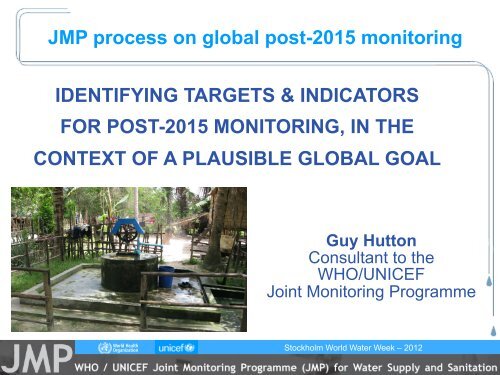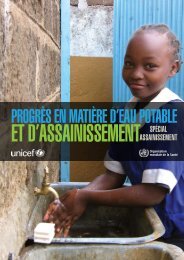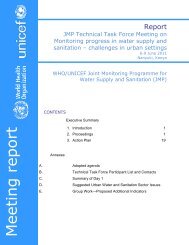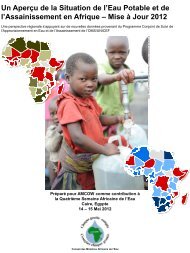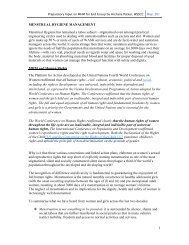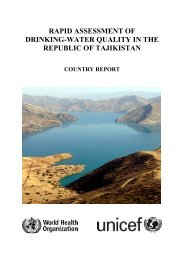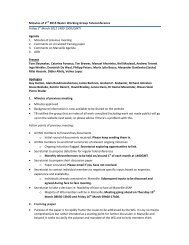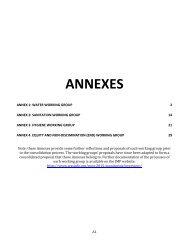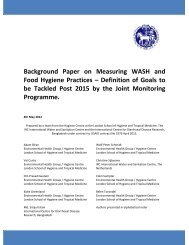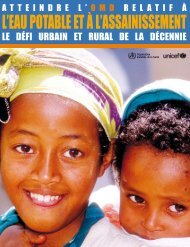overview and results of the working groups - UNICEF Joint ...
overview and results of the working groups - UNICEF Joint ...
overview and results of the working groups - UNICEF Joint ...
You also want an ePaper? Increase the reach of your titles
YUMPU automatically turns print PDFs into web optimized ePapers that Google loves.
JMP process on global post-2015 monitoring<br />
IDENTIFYING TARGETS & INDICATORS<br />
FOR POST-2015 MONITORING, IN THE<br />
CONTEXT OF A PLAUSIBLE GLOBAL GOAL<br />
Guy Hutton<br />
Consultant to <strong>the</strong><br />
WHO/<strong>UNICEF</strong><br />
<strong>Joint</strong> Monitoring Programme<br />
Stockholm World Water Week – 2012
Purposes <strong>of</strong> Global Monitoring<br />
• Global advocacy<br />
• Measuring progress for <strong>the</strong> global community<br />
• Informing global investments<br />
• Supporting regional <strong>and</strong> country<br />
benchmarking <strong>and</strong> reporting<br />
• Informing investments at country level by<br />
governments <strong>and</strong> donors<br />
Focus on national governments as <strong>the</strong> client<br />
Stockholm World Water Week – 2012<br />
2<br />
2
Current MDG target <strong>and</strong> indicator<br />
• Target: Halve, by 2015, <strong>the</strong> proportion <strong>of</strong> people without sustainable<br />
access to safe drinking water <strong>and</strong> basic sanitation<br />
• Indicator: Proportion <strong>of</strong> population using an improved drinking water<br />
source<br />
Strengths<br />
Simple. Strong message/tool<br />
Realistic/achievable<br />
Focuses on ends ra<strong>the</strong>r than means<br />
(flexible to context)<br />
Successfully raised pr<strong>of</strong>ile <strong>of</strong> water <strong>and</strong><br />
sanitation issues <strong>and</strong> focused attention on<br />
scale <strong>of</strong> problem globally <strong>and</strong> at national<br />
level<br />
Weaknesses<br />
Lacks ambition - focuses only on<br />
basic/minimum level <strong>of</strong> service<br />
Average figures mask disparities within<br />
population – focus on easy to reach<br />
Definition <strong>of</strong> ‘improved facility’<br />
inadequate proxy for ‘services’<br />
Incentivizes new services over existing<br />
Defined for global not national level<br />
Stockholm World Water Week – 2012<br />
3<br />
3
Aims <strong>of</strong> <strong>the</strong> Post-2015 Process<br />
• Through broad consultation with experts <strong>and</strong><br />
stakeholders, to propose a menu <strong>of</strong> improved global<br />
WASH targets with corresponding indicators,<br />
incorporating human rights principles, to set <strong>the</strong><br />
direction <strong>of</strong> <strong>the</strong> WASH sector development after 2015<br />
• Select from <strong>the</strong>se <strong>the</strong> most “bankable” ones congruent<br />
with a possible Sustainable Development Goal on<br />
WASH<br />
• Identify <strong>the</strong> means by which <strong>the</strong>se targets <strong>and</strong><br />
indicators will be measured (measurability <strong>and</strong> global<br />
monitoring architecture)<br />
Stockholm World Water Week – 2012<br />
4<br />
4
Funneling Process for Targets <strong>and</strong> Indicators<br />
Universe <strong>of</strong><br />
targets <strong>and</strong><br />
indicators<br />
Stockholm World Water Week – 2012<br />
Targets <strong>and</strong><br />
indicators <strong>of</strong><br />
global relevance<br />
Targets <strong>and</strong><br />
indicators<br />
proposed for<br />
global monitoring<br />
Targets <strong>and</strong><br />
indicators for<br />
SDG framework<br />
5<br />
5
JANUARY 2012<br />
JULY 2012<br />
DECEMBER 2012<br />
Overview <strong>of</strong> Process<br />
LONG<br />
LISTING<br />
SHORT<br />
LISTING<br />
Identify through expert<br />
<strong>and</strong> stakeholder<br />
consultation <strong>the</strong> range<br />
<strong>of</strong> global WASH targets<br />
<strong>and</strong> indicators<br />
Assess which are most<br />
technically <strong>and</strong><br />
politically feasible for<br />
global monitoring <strong>and</strong><br />
for <strong>the</strong> SDG<br />
Stockholm World Water Week – 2012<br />
6<br />
6
Summary <strong>of</strong> Process Until July 2012<br />
Long List <strong>of</strong> Global Goals, Targets <strong>and</strong> Indicators<br />
TIME<br />
LONG LIST<br />
Berlin<br />
Consultation<br />
Identification <strong>of</strong> Chairs/<br />
Experts & Initiation <strong>of</strong><br />
4 Working Groups<br />
Meetings <strong>of</strong> Working Groups<br />
<strong>and</strong> Initial Outreach<br />
Communication at global <strong>and</strong> regional<br />
water events <strong>and</strong> to UN system<br />
WASH goals <strong>and</strong> “long list” <strong>of</strong> target <strong>and</strong> indicator<br />
options from <strong>working</strong> <strong>groups</strong><br />
Stockholm World Water Week – 2012<br />
7<br />
7
Summary <strong>of</strong> Process From July 2012<br />
Refining Global Goal, Targets <strong>and</strong> Indicators<br />
WASH SECTOR BROADER<br />
August<br />
September<br />
October<br />
JMP / WG Consultation Document “1” –<br />
compiled, unconsolidated<br />
Fur<strong>the</strong>r JMP Urban<br />
Online<br />
public & WG Taskforce<br />
“1”<br />
meetings Work (UNC)<br />
JMP / WG Consultation Document “2”<br />
- consolidated, full indicator listing<br />
C<br />
o<br />
m<br />
m<br />
u<br />
n<br />
i<br />
c<br />
a<br />
C<br />
o<br />
n<br />
s<br />
u<br />
l<br />
t<br />
a<br />
C<br />
o<br />
o<br />
r<br />
d<br />
i<br />
n<br />
a<br />
SG’s High<br />
Level Panel<br />
Intergovernmental<br />
<strong>working</strong> group<br />
Thematic<br />
consultations<br />
November<br />
Online<br />
“2”<br />
<strong>and</strong><br />
e-survey<br />
Regional <strong>and</strong> country<br />
consultations / sharing<br />
Measurability meeting<br />
t<br />
i<br />
o<br />
n<br />
t<br />
i<br />
o<br />
n<br />
t<br />
i<br />
o<br />
n<br />
Initiation <strong>of</strong><br />
process in<br />
o<strong>the</strong>r linked<br />
sectors<br />
Country<br />
Documentation for The Hague meeting<br />
consultations<br />
Stockholm World Water Week – 2012<br />
8<br />
8
December<br />
2012<br />
January<br />
2013<br />
February<br />
March<br />
April<br />
May-June<br />
September<br />
Summary <strong>of</strong> Process From December 2012<br />
Refining Global Goal, Targets <strong>and</strong> Indicators<br />
Online<br />
“3”<br />
Indicator<br />
validation<br />
WASH SECTOR BROADER<br />
The Hague meeting<br />
Meeting report with proposals<br />
Regional & country<br />
consultations<br />
Global monitoring<br />
architecture<br />
IRC Symposium<br />
Consolidation – core group<br />
C<br />
o<br />
m<br />
m<br />
u<br />
n<br />
i<br />
c<br />
a<br />
t<br />
i<br />
o<br />
n<br />
C<br />
o<br />
n<br />
s<br />
u<br />
l<br />
t<br />
a<br />
t<br />
i<br />
o<br />
n<br />
Proposals to UNGA<br />
C<br />
o<br />
o<br />
r<br />
d<br />
i<br />
n<br />
a<br />
t<br />
i<br />
o<br />
n<br />
Water Thematic<br />
consultation?<br />
& coordination with<br />
o<strong>the</strong>r <strong>the</strong>matic areas<br />
Country<br />
consultations<br />
Stockholm World Water Week – 2012<br />
Report <strong>of</strong> HLP<br />
Report <strong>of</strong><br />
Intergovernmental<br />
<strong>working</strong> group<br />
9<br />
9
Thank you for listening<br />
WHO / <strong>UNICEF</strong><br />
<strong>Joint</strong> Monitoring Programme<br />
www.wssinfo.org<br />
World Health Organization<br />
Water, Sanitation, Hygiene <strong>and</strong> Health<br />
www.who.int/water_sanitation_health<br />
<strong>UNICEF</strong><br />
Water, Sanitation <strong>and</strong> Hygiene<br />
www.unicef.int<br />
Stockholm World Water Week – 2012
JMP Post-2015 Process on Global Monitoring<br />
Sanitation<br />
Working Group<br />
Eddy Perez, Working Group Coordinator<br />
Water <strong>and</strong> Sanita7on Program
Activities <strong>of</strong> <strong>the</strong><br />
Sanitation Working Group<br />
January 2012<br />
Constitution <strong>of</strong> Sanitation Working Group<br />
February 2012:<br />
Preparation <strong>of</strong> Background Paper<br />
Face-to-face meeting <strong>of</strong> core group, Washington DC<br />
May 2012:<br />
Webinar for wider group, including reference group<br />
June 2012:<br />
Audio conference <strong>of</strong> core group<br />
Planned for September 2012:<br />
Face-to-face meeting <strong>of</strong> core group, London<br />
2
Through this process <strong>the</strong> group:<br />
• Defined a proposed overall goal<br />
• Develop a long list <strong>of</strong> targets <strong>and</strong> <strong>the</strong>n shortened it to a<br />
list <strong>of</strong> four<br />
• Developed lists <strong>of</strong> indictors that could be used for each<br />
target<br />
• Began development <strong>of</strong> defini8ons <strong>of</strong> <strong>the</strong> terms used in<br />
<strong>the</strong> targets<br />
• Iden8fied possible sources <strong>of</strong> data<br />
• Developed a list <strong>of</strong> o<strong>the</strong>r parameters, not included in <strong>the</strong><br />
targets, that we felt it was important to monitor<br />
3
Proposed Overall Sanitation<br />
Goal<br />
Universal use <strong>of</strong> sustainable<br />
sanitation services that protect public<br />
health <strong>and</strong> dignity<br />
4
Proposed Targets<br />
1. By 2030, no-one practices open defecation<br />
2. By 2030, 80% <strong>of</strong> <strong>the</strong> poorest quintile, <strong>and</strong> 80% <strong>of</strong> <strong>the</strong><br />
entire population uses an adequate sanitation facility<br />
3. By 2030, <strong>the</strong> excreta <strong>of</strong> 50% <strong>of</strong> households is safely<br />
stored, transported, <strong>and</strong> adequately treated, before<br />
being ei<strong>the</strong>r re-used or safely returned to <strong>the</strong><br />
environment<br />
4. By 2030, all schools <strong>and</strong> health facilities <strong>of</strong>fer<br />
adequate sanitation facilities to all users<br />
5
Target 1: By 2025, no-one practices open<br />
defecation<br />
Proposed Indicators<br />
1. Percentage <strong>of</strong> households in <strong>the</strong> lowest wealth quin8le<br />
prac8cing OD<br />
2. Percentage <strong>of</strong> total, urban <strong>and</strong> rural households prac8cing OD<br />
3. Percentage <strong>of</strong> households with children under 5 repor8ng<br />
hygienic disposal <strong>of</strong> <strong>the</strong>ir stools<br />
4. Percentage <strong>of</strong> households in which OD is prac8ced by any<br />
members <strong>of</strong> household (men, women, children over 5)<br />
6
Target 2: By 2030, 80% <strong>of</strong> poorest quintile, <strong>and</strong> 80%<br />
<strong>of</strong> <strong>the</strong> entire population uses an adequate sanitation<br />
facility<br />
Proposed Indicators<br />
1. Percentage <strong>of</strong> households using adequate sanita8on facility<br />
(disaggregated urban <strong>and</strong> rural <strong>and</strong> by wealth quin8les)<br />
2. Percentage <strong>of</strong> households in which <strong>the</strong> sanita8on facility is used<br />
by all members <strong>of</strong> household (including men <strong>and</strong> women, boys<br />
<strong>and</strong> girls, elderly, people with disabili8es) whenever needed<br />
3. Percentage <strong>of</strong> total popula8on using an adequate sanita8on<br />
facility<br />
7
Definition: ‘Adequate’ sanitation<br />
• Separates excreta from human contact <strong>and</strong> ensures that<br />
excreta does not re-enter <strong>the</strong> immediate household<br />
environment<br />
• Safe (protects <strong>the</strong> user from risks such as vermin, falling<br />
into <strong>the</strong> pit)<br />
• Durable<br />
• Household or shared toilet within or nearby <strong>the</strong> plot, shared<br />
by no more than 5 families or 30 people, whichever is<br />
fewer, <strong>and</strong> used by people who know each o<strong>the</strong>r<br />
• Accessible at all times (7 days a week, 24 hours a day)<br />
• Accessible to all members <strong>of</strong> household, including those<br />
with disabilities<br />
• Protects users from culturally-inappropriate exposure or<br />
invasion <strong>of</strong> privacy<br />
8
Target 3: By 2030, <strong>the</strong> excreta <strong>of</strong> 50% <strong>of</strong> households<br />
is safely stored <strong>and</strong> transported, <strong>and</strong> adequately<br />
treated before being re-used or discharged to <strong>the</strong><br />
environment<br />
Proposed Indicators<br />
1. Percentage <strong>of</strong> <strong>the</strong> total popula8on served by a<br />
func8oning sanita8on service chain, disaggregated by<br />
urban <strong>and</strong> rural, <strong>and</strong> by wealth quin8les<br />
2. Quan8ty <strong>of</strong> fecal maIer in <strong>the</strong> environment<br />
9
Target 4: By 2025, all schools <strong>and</strong> health facilities<br />
<strong>of</strong>fer adequate sanitation facilities to all users<br />
Proposed Indicators<br />
1. Percentage <strong>of</strong> schools with separate <strong>and</strong> adequate facili8es, used by all, for<br />
boys <strong>and</strong> girls<br />
2. Percentage <strong>of</strong> health facili8es with separate <strong>and</strong> adequate facili8es, used by<br />
all, for men <strong>and</strong> women<br />
10
Definition: ‘Separate <strong>and</strong> adequate’ sanitation in<br />
schools <strong>and</strong> health facilities<br />
• No more than xx users per seat or cubicle in schools<br />
• Gender specific; separate for girls <strong>and</strong> boys<br />
• Includes facilities for menstrual hygiene management<br />
(disposal for MHM materials)<br />
• Includes facilities for h<strong>and</strong>washing with soap <strong>and</strong> water<br />
• Accommodates needs <strong>of</strong> children with disabilities<br />
11
O<strong>the</strong>r parameters to monitor<br />
Parameter! Proposed Indicators<br />
Affordability • Percentage <strong>of</strong> monthly/yearly income that household spends on<br />
sanita8on, disaggregated by wealth quin8le<br />
Community-‐wide sanita8on • Percentage <strong>of</strong> communi8es that are cer8fied “Open Defeca8on<br />
Free”<br />
Public expenditure • Percentage <strong>of</strong> GDP spent on sanita8on<br />
• Percentage <strong>of</strong> aid spent on sanita8on<br />
• Percentage <strong>of</strong> countries that have a separate na8onal budget<br />
line for sanita8on<br />
Discrimina8on <strong>and</strong> Exclusion • Coverage <strong>of</strong> adequate facili8es within “non-‐dominant” <strong>groups</strong><br />
(defined by mo<strong>the</strong>r tongue, race, caste, occupa8on)<br />
Progress against <strong>the</strong> old<br />
“improved” defini8on<br />
• Percent <strong>of</strong> popula8on using “improved” sanita8on as per<br />
pre-‐2015 defini8on<br />
12
Acknowledgements:<br />
WG Members – Core Group<br />
1. Eddy Perez, Water <strong>and</strong> Sanitation Program, World Bank (WG lead)<br />
2. Clarissa Brocklehurst, Consultant<br />
3. S<strong>and</strong>y Cairncross, LSHTM/SHARE Consortium, UK<br />
4. Cassilda Carvalho, Association <strong>of</strong> Sanitary <strong>and</strong> Environmental<br />
Engineering, Brazil<br />
5. Andy Cotton, WEDC, Loughborough University, UK<br />
6. Jena Davis, Stanford University, USA<br />
7. Therese Dooley, <strong>UNICEF</strong><br />
8. Guy Hutton, <strong>Joint</strong> Monitoring Programme<br />
9. Pete Kolsky, Water Institute, University <strong>of</strong> North Carolina, USA<br />
10. Alex McPhail, World Bank<br />
11. Virginia Roaf, Team <strong>of</strong> UN Special Rapporteur on Human Right to Water &<br />
Sanitation<br />
12. Yaw Asante Sarkodie, Ministry <strong>of</strong> Water Resources, Works & Housing,<br />
Ghana<br />
13. Darren Saywell, Plan International<br />
14. Chris Zurbruegg, EAWAG, Switzerl<strong>and</strong><br />
15. Alix Zwane, Bill <strong>and</strong> Melinda Gates Foundation<br />
13
Acknowledgements:<br />
WG Members– Reference Group<br />
1. Maria Julia Bocco, Inter-American Development Bank<br />
2. Ned Breslin, Water For People<br />
3. Bertha Briceno, Water <strong>and</strong> Sanitation Program, World Bank<br />
4. Alex<strong>and</strong>er Danilenko, IBNET, Water <strong>and</strong> Sanitation Program, World Bank<br />
5. Barbara Evans, University <strong>of</strong> Leeds, UK<br />
6. Soma Ghosh, World Bank<br />
7. Rifat Hossain, JMP, World Health Organization<br />
8. Anupma Jain, Asian Development Bank<br />
9. Rolf Luyendijk, JMP, <strong>UNICEF</strong><br />
10. Meera Mehta, CEPT University, India<br />
11. Eric Mintz, Centers for Disease Control, USA<br />
12. Elisabeth von Müench, GIZ/SUSANA, Germany<br />
13. Ada Oko-Williams, WaterAid Africa<br />
14. Archana Patkar, Water Supply <strong>and</strong> Sanitation Collaborative Council<br />
15. Antonio Rodriguez Serrano, Water <strong>and</strong> Sanitation Program, World Bank<br />
16. Gary White, Water.Org<br />
17. Joep Verhagen, IRC<br />
18. Dominick de Waal, Water <strong>and</strong> Sanitation Program, World Bank<br />
14
JMP post-2015 process on global monitoring<br />
HYGIENE<br />
WORKING GROUP<br />
Merri Weinger<br />
USAID<br />
United States <strong>of</strong> America<br />
World Singapore Water International Week in Water Stockholm Week – 4 2012 July 2012
Areas <strong>of</strong> Focus<br />
H<strong>and</strong>washing<br />
Food Hygiene<br />
Menstrual Hygiene<br />
Management<br />
World Singapore Water International Week in Water Stockholm Week – 4 2012 July 2012<br />
2
Overall Hygiene Goal<br />
“Hygiene (h<strong>and</strong>washing, food hygiene, menstrual<br />
hygiene management) will be universally recognized,<br />
promoted, <strong>and</strong> practiced as fundamental to good<br />
health, dignity <strong>and</strong> quality <strong>of</strong> life”<br />
World Singapore Water International Week in Water Stockholm Week – 4 2012 July 2012<br />
3
Targets <strong>and</strong> Indicators: Selection Criteria<br />
• Evidence <strong>of</strong> association with health <strong>and</strong> non-health benefits<br />
(social <strong>and</strong> economic)<br />
• Global relevance<br />
• Measurability (including feasibility, cost <strong>of</strong> data collection,<br />
<strong>and</strong> potential for low/no bias)<br />
• Achievability<br />
• Potential to address/correct discriminatory practices<br />
World Singapore Water International Week in Water Stockholm Week – 4 2012 July 2012<br />
4
Targets<br />
H<strong>and</strong>washing<br />
1: Ensure universal access to h<strong>and</strong>washing facilities<br />
2: To halve <strong>the</strong> proportion <strong>of</strong> critical times when h<strong>and</strong>s are not washed with soap<br />
3: Every government will have policies <strong>and</strong> programs in place to promote <strong>the</strong><br />
practice <strong>of</strong> h<strong>and</strong>washing with soap<br />
Food Hygiene<br />
1: By Year XX, each country prioritizes food hygiene in policies <strong>and</strong> strategy<br />
2. By Year XX, improved food hygiene behavior practiced by a significant<br />
proportion <strong>of</strong> <strong>the</strong> population involved in food preparation <strong>and</strong> h<strong>and</strong>ling<br />
Menstrual Hygiene Management<br />
1: By 2040 all women <strong>and</strong> adolescent girls are able to manage menstruation<br />
hygienically <strong>and</strong> with dignity<br />
World Singapore Water International Week in Water Stockholm Week – 4 2012 July 2012<br />
5
H<strong>and</strong>washing Target: Ensure universal access<br />
to h<strong>and</strong>washing facilities<br />
Proposed Indicators<br />
1. % <strong>of</strong> households with soap <strong>and</strong> water present at <strong>the</strong><br />
designated h<strong>and</strong>washing facility<br />
2. % <strong>of</strong> schools with adequate access to h<strong>and</strong>washing<br />
facilities with soap <strong>and</strong> water<br />
3. % <strong>of</strong> health care institutions with fully equipped<br />
h<strong>and</strong>washing facilities<br />
4. % <strong>of</strong> birthing locations with fully equipped h<strong>and</strong>washing<br />
stations<br />
World Singapore Water International Week in Water Stockholm Week – 4 2012 July 2012<br />
6
Food Hygiene Target 1: By Year XX, each country<br />
prioritizes food hygiene in policies <strong>and</strong> strategy<br />
Proposed Indicator<br />
% <strong>of</strong> lower <strong>and</strong> middle income countries enforcing<br />
international food safety recommendations in any <strong>of</strong> <strong>the</strong>ir<br />
child meal programs<br />
World Singapore Water International Week in Water Stockholm Week – 4 2012 July 2012<br />
7
Food Hygiene Target 2: By Year XX, improved food hygiene<br />
behavior practiced by a significant proportion <strong>of</strong> <strong>the</strong> population<br />
involved in food preparation <strong>and</strong> h<strong>and</strong>ling<br />
Proposed Indicators<br />
1. % <strong>of</strong> households that have running water into <strong>the</strong><br />
dwelling<br />
2. % <strong>of</strong> households with soap <strong>and</strong> water at h<strong>and</strong>washing<br />
facility in area where food is prepared<br />
World Singapore Water International Week in Water Stockholm Week – 4 2012 July 2012<br />
8
Menstrual Hygiene Management Target: By 2040 all women <strong>and</strong><br />
adolescent girls are able to manage menstruation hygienically <strong>and</strong><br />
with dignity<br />
Proposed Indicators<br />
1. % <strong>of</strong> schools <strong>and</strong> primary health facilities<br />
distributing/disseminating accurate, contextually<br />
appropriate, pragmatic menstrual management information<br />
2. % <strong>of</strong> teachers <strong>and</strong> healthcare workers who can answer a<br />
set <strong>of</strong> basic questions on MHM<br />
3. % <strong>of</strong> public facilities, schools, institutions, transport hubs<br />
<strong>and</strong> markets that provide gender separated latrines with<br />
water <strong>and</strong> soap <strong>and</strong> disposal facilities for menstrual<br />
materials<br />
World Singapore Water International Week in Water Stockholm Week – 4 2012 July 2012<br />
9
Group Structure <strong>and</strong> Membership<br />
H<strong>and</strong> Washing:<br />
Valerie Curtis, LSHTM<br />
Jacqueline Devine, WSP<br />
Sonya Hammons, US State Department<br />
Guy Hutton, WHO/JMP<br />
Khairul Islam, WaterAid, Bangladesh<br />
Pavani Ram, SUNY, Buffalo<br />
Abdou-Salam Savadogo, WHO<br />
Merri Weinger, USAID (Chair)<br />
Food Hygiene:<br />
Peter Ben Embarek, WHO<br />
Zulfiqar Bhutta, Aga Khan University (Pakistan)<br />
John Ehiri, University <strong>of</strong> Arizona<br />
Orl<strong>and</strong>o Hern<strong>and</strong>ez, USAID/WASHplus<br />
Claudio Lanata, Nutrition Research Institute<br />
(Peru)<br />
Ousmane Toure, Universite de Bamako (Mali)<br />
Monica Woldt, USAID/FANTA<br />
Menstrual Hygiene Management:<br />
Marni Sommer, Columbia University<br />
Therese Mahon, WaterAid, South Asia<br />
Alana Potter, IRC<br />
Rolf Luyendijk, <strong>UNICEF</strong><br />
Virginia Roaf, UN Human Rights Rapporteur<br />
World Singapore Water International Week in Water Stockholm Week – 4 2012 July 2012<br />
10
Thank you for listening<br />
WHO / <strong>UNICEF</strong><br />
<strong>Joint</strong> Monitoring Programme<br />
www.wssinfo.org<br />
World Health Organization<br />
Water, Sanitation, Hygiene <strong>and</strong> Health<br />
www.who.int/water_sanitation_health<br />
<strong>UNICEF</strong><br />
Water, Sanitation <strong>and</strong> Hygiene<br />
www.unicef.int<br />
World Singapore Water International Week in Water Stockholm Week – 4 2012 July 2012
JMP post-2015 process on global monitoring<br />
Preparing <strong>the</strong> Next Generation <strong>of</strong> Goals, Targets <strong>and</strong> Indicators<br />
Stockholm World Water Week, 30 th August<br />
Monitoring Drinking Water:<br />
<strong>overview</strong> <strong>and</strong> proposals<br />
Tom Slaymaker<br />
Deputy Head <strong>of</strong> Policy, WaterAid<br />
Lead, JMP post2015 Water Working Group<br />
tomslaymaker@wateraid.org<br />
Stockholm World Water Week – 30 August 2012
Water Working Group Membership<br />
• National governments: Mozambique, South Africa,<br />
Madagascar, Ghana, Ug<strong>and</strong>a, India<br />
• Donor agencies: Inter-American Development Bank, GIZ,<br />
WSP<br />
• NGOs: WaterAid, IRC (leads <strong>of</strong> <strong>the</strong> <strong>working</strong> group)<br />
• Academia/research: University North Carolina, Eawag,<br />
ICF (DHS), German Institute for Human Rights, Stamford<br />
University<br />
• UN: WHO, <strong>UNICEF</strong>, UN-Habitat<br />
• Pr<strong>of</strong>essional Networks: RWSN, IBNET-WSP<br />
All documents/minutes available http://watermonitoring2015.org/<br />
Stockholm World Water Week – 30 August 2012<br />
2
Goal content <strong>and</strong> definition<br />
• We agree that it should be a simple, inspirational <strong>and</strong><br />
communicable expression <strong>of</strong> <strong>the</strong> progressive realisation<br />
<strong>of</strong> <strong>the</strong> HRTWS by everyone:<br />
• Water for all<br />
• Drinking-water services for all<br />
• Sustainable drinking water for all<br />
• Safe, sustainable water for all<br />
• Safe, sustainable drinking water for all<br />
• Equal access to safe <strong>and</strong> sustainable water for all<br />
• Water for everyone, forever<br />
Stockholm World Water Week – 30 August 2012<br />
3
Target content <strong>and</strong> definition<br />
• Unrealistic to expect politicians to accept a long list <strong>of</strong><br />
targets<br />
• Aim for small number <strong>of</strong> targets combining universal<br />
access to basic services <strong>and</strong> progressive improvement in<br />
existing service levels<br />
• Focus on improving access at home <strong>and</strong> in extra-hh<br />
settings with explicit focus on disadvantaged <strong>groups</strong><br />
• Move away from improved/unimproved terminology but<br />
retain <strong>the</strong> idea <strong>of</strong> a basic ‘threshold’ for everyone<br />
• Use normative criteria <strong>of</strong> HRTWS <strong>and</strong> service ladder<br />
concept as guiding principles<br />
Stockholm World Water Week – 30 August 2012<br />
4
What defines a service (criteria)?<br />
Criterion GC 15 IE 2010 WWG<br />
Sufficient quantity<br />
Continuity <strong>of</strong> service<br />
Safe for health<br />
Aes<strong>the</strong>tically<br />
acceptable<br />
Time/distance required<br />
to collect<br />
Suitable for use by all,<br />
including disabled <strong>and</strong><br />
older people<br />
Affordable<br />
Availability Availability Availability<br />
Quality<br />
Accessibility<br />
(physical)<br />
Accessibility<br />
(economic)<br />
Quality/safety<br />
Acceptability<br />
Quality<br />
Accessibility Accessibility<br />
Affordability Affordability<br />
Non-discrimination Accessibility (Cross-cutting) (Cross-cutting)<br />
Stockholm World Water Week – 30 August 2012<br />
5
Draft targets x4<br />
1. By 2030, EVERYBODY has equitable access to a basic<br />
drinking water service at home.<br />
2. To halve, by 2030, <strong>the</strong> proportion <strong>of</strong> people, including<br />
disadvantaged <strong>groups</strong>, without equitable access to a higher<br />
water service at home.<br />
3. By 2030, EVERYBODY has equitable access to a basic<br />
water [sanitation <strong>and</strong> hygiene] services in <strong>the</strong>ir schools <strong>and</strong><br />
health facilities.<br />
-----<br />
4. Water [sanitation <strong>and</strong> hygiene] services are delivered in a<br />
financially, operationally institutionally, <strong>and</strong> environmentally<br />
sustainable manner.<br />
Stockholm World Water Week – 30 August 2012<br />
6
Draft c<strong>and</strong>idate indicators (hh) – in progress<br />
Basic Improved<br />
source<br />
Intermediate/<br />
higher<br />
Availability Quality Accessibility Affordability<br />
50 lpcd, with<br />
year-round<br />
service but<br />
some (daily or<br />
weekly)<br />
interruptions<br />
Improved<br />
source<br />
E coli < 1<br />
CFU/100 mL<br />
Collection time<br />
< 30 minutes<br />
Collection time<br />
< 10 minutes<br />
No threshold<br />
specified<br />
WASH<br />
expenditures<br />
as proportion<br />
<strong>of</strong> household<br />
income < 5%<br />
Stockholm World Water Week – 30 August 2012<br />
7
Draft c<strong>and</strong>idate indicators (extra-hh) – in progress<br />
Availability Quality Accessibility<br />
Basic in schools Capable <strong>of</strong> delivering<br />
5lpcpd<br />
Basic in health<br />
facilities<br />
Intermediate/<br />
higher in schools<br />
Intermediate/<br />
higher in HF<br />
+ workplaces<br />
+ markets<br />
+ transit facilities<br />
Capable <strong>of</strong> delivering<br />
min WHO st<strong>and</strong>ard/<br />
facility type<br />
24/7 reliability<br />
providing >50lpcpd<br />
24/7 reliability<br />
providing >50lpcpd<br />
Improved source Water point located with<br />
250m <strong>and</strong> accessible to<br />
all users<br />
Improved source Water point located on<br />
facility premises <strong>and</strong><br />
accessible to all users<br />
Water meets WHO<br />
facility st<strong>and</strong>ards<br />
Water meets WHO<br />
facility st<strong>and</strong>ards<br />
Water point located on<br />
premises <strong>and</strong> accessible<br />
to all users<br />
Water point located on<br />
facility premises <strong>and</strong><br />
accessible to all users<br />
Stockholm World Water Week – 30 August 2012<br />
8
Service threshold definitions – in progress<br />
• Basic hh service:<br />
Drinking water collected from an improved source (proxy for<br />
both availability <strong>and</strong> quality), within 30 minutes per trip<br />
(accessibility)<br />
• Intermediate/higher hh service:<br />
Drinking water collected from a source that supplies 50 litres<br />
per capita per day year-round (with daily or weekly<br />
interruptions in supply), requiring no more than 10 minutes to<br />
collect. No detectable E. coli in a 100 mL sample. Combined<br />
expenditures on water, sanitation <strong>and</strong> hygiene cost no more<br />
than 5% <strong>of</strong> disposable household income.<br />
Stockholm World Water Week – 30 August 2012<br />
9
Next steps<br />
• Developing definitions for basic <strong>and</strong> intermediate/higher in<br />
extra-hh settings (schools, health facilities, workplaces,<br />
o<strong>the</strong>rs)<br />
• Developing definitions <strong>and</strong> indicators for sustainability (linking<br />
with o<strong>the</strong>r emerging goals <strong>and</strong> targets on sustainability)<br />
• Consolidating with goal, target <strong>and</strong> indicator proposals from<br />
o<strong>the</strong>r <strong>working</strong> <strong>groups</strong><br />
Stockholm World Water Week – 30 August 2012<br />
10
Thank you for listening<br />
Water <strong>working</strong> group<br />
Documentation <strong>of</strong> process<br />
http://watermonitoring2015.org<br />
WHO / <strong>UNICEF</strong><br />
<strong>Joint</strong> Monitoring Programme<br />
www.wssinfo.org<br />
World Health Organization<br />
Water, Sanitation, Hygiene <strong>and</strong> Health<br />
www.who.int/water_sanitation_health<br />
<strong>UNICEF</strong><br />
Water, Sanitation <strong>and</strong> Hygiene<br />
www.unicef.int<br />
Stockholm World Water Week – 30 August 2012
JMP Post-2015 Process on Global Monitoring<br />
Recommendations <strong>of</strong><br />
<strong>the</strong> Equity <strong>and</strong><br />
Non-Discrimination<br />
Working Group<br />
Catarina de Albuquerque<br />
UN Special Rapporteur on <strong>the</strong><br />
Human Right to Safe Drinking<br />
Water <strong>and</strong> Sanitation<br />
World Water Week – 30 August 2012
Outline: Integrating END in Post-2015<br />
Monitoring<br />
• Why…?<br />
– The Inequality Blind-Spot<br />
– Striking Disparities<br />
• What…?<br />
– The Equality Checklist<br />
– Elements for Goals, Targets, <strong>and</strong> Indicators<br />
• How…?<br />
– Improving <strong>and</strong> Exp<strong>and</strong>ing Measurement <strong>and</strong> Data<br />
Sources<br />
World Water Week – 30 August 2012<br />
2
Why: The Inequality Blind-Spot<br />
• MDGs silent on discrimination, inequalities <strong>and</strong><br />
disparities<br />
• Focus on average attainment<br />
• At least in <strong>the</strong>ory, targets can be achieved without<br />
benefitting a single person with a disability, a single<br />
person belonging to an ethnic minority, or a single<br />
person living in extreme poverty<br />
• Achievement <strong>of</strong> <strong>the</strong> MDGs becomes unattainable<br />
without addressing inequalities<br />
• Need to redefine progress – it must not be called<br />
progress when significant parts <strong>of</strong> <strong>the</strong> population are<br />
left behind<br />
World Water Week – 30 August 2012<br />
3
100%<br />
90%<br />
80%<br />
70%<br />
60%<br />
50%<br />
40%<br />
30%<br />
20%<br />
10%<br />
0%<br />
Why: Striking Disparities: Urban-Rural<br />
1990 2010<br />
All water<br />
infrastructure+surface<br />
water<br />
All water infrastructure<br />
Improved water sources<br />
Safe water sources<br />
safe water sources that<br />
is within 30mins <strong>of</strong> home<br />
safe water sources at<br />
home<br />
100%<br />
90%<br />
80%<br />
70%<br />
60%<br />
50%<br />
40%<br />
30%<br />
20%<br />
10%<br />
0%<br />
1990 2010<br />
Urban Rural<br />
World Water Week – 30 August 2012<br />
All water<br />
infrastructure+surface<br />
water<br />
All water infrastructure<br />
Improved water sources<br />
Safe water sources<br />
safe water sources that<br />
is within 30mins <strong>of</strong> home<br />
safe water sources at<br />
home<br />
Urban-Rural disparities (2010)<br />
Improved water: 93% vs. 44%, safe water at home: 45% vs. 0.2%<br />
4
Why: Striking Disparities: Rich-Poor<br />
7<br />
Poorest<br />
57<br />
31<br />
5<br />
37<br />
36<br />
16<br />
11<br />
40<br />
16<br />
Poor<br />
34<br />
10<br />
0<br />
48<br />
32<br />
20<br />
32<br />
31<br />
24<br />
Middle<br />
0<br />
41<br />
38<br />
21<br />
13 Open defecation<br />
Unimproved facilities<br />
Shared improved<br />
facilities<br />
Improved facilities<br />
12<br />
26<br />
36<br />
Rich<br />
27<br />
0<br />
24<br />
44<br />
32<br />
World Water Week – 30 August 2012<br />
4<br />
13<br />
36<br />
Richest<br />
Rich-poor gap (rural): 42%pt (2000), 40%pt (2008)<br />
47<br />
0<br />
9<br />
40<br />
51<br />
5
What: Monitoring Non-Discrimination <strong>and</strong><br />
Equality<br />
• How is progress distributed? Who is excluded?<br />
• Set incentives to reduce inequalities <strong>and</strong> focus on <strong>the</strong><br />
most disadvantaged<br />
• Targets must ensure that <strong>the</strong> most disadvantaged,<br />
marginalized <strong>and</strong> discriminated against are reached<br />
• Disaggregation needs to go beyond rural / urban<br />
• Current wealth quintile analysis is very powerful, but not<br />
sufficient<br />
• Link to prohibited grounds <strong>of</strong> discrimination to<br />
underst<strong>and</strong> who lacks access <strong>and</strong> why<br />
World Water Week – 30 August 2012<br />
6
What: The Equality Checklist<br />
• Prioritize basic access <strong>and</strong> focus on progressive<br />
realization toward safe <strong>and</strong> sustainable water, sanitation<br />
<strong>and</strong> hygiene for all, while reducing inequalities<br />
• Address spatial inequalities, such as those experienced<br />
by communities in remote <strong>and</strong> inaccessible rural areas<br />
<strong>and</strong> slum-dwellers in (peri-)urban areas<br />
• Focus on inequities, shining <strong>the</strong> light on <strong>the</strong> poorest <strong>of</strong><br />
<strong>the</strong> poor<br />
World Water Week – 30 August 2012<br />
7
What: The Equality Checklist (Cont’d)<br />
• Address group-related inequalities that vary across<br />
countries, such as those based on ethnicity, race,<br />
nationality, language, religion, <strong>and</strong> caste<br />
• Attend to <strong>the</strong> impacts <strong>of</strong> individual-related inequalities<br />
relevant in every country <strong>of</strong> <strong>the</strong> globe, such as those<br />
based on sex/gender, age, disability, <strong>and</strong> health<br />
conditions imposing access constraints—as experienced<br />
both inside <strong>and</strong> beyond <strong>the</strong> household, including in<br />
relation to menstrual hygiene management<br />
World Water Week – 30 August 2012<br />
8
What: Elements for Goals, Targets, <strong>and</strong><br />
Indicators<br />
• Adopt a st<strong>and</strong>-alone goal on equality in <strong>the</strong> overall architecture <strong>of</strong><br />
post-2015 development goals<br />
• Include attention to both universality <strong>and</strong> elimination <strong>of</strong> inequalities<br />
in <strong>the</strong> WASH goal<br />
• Include targets <strong>and</strong> indicators that require <strong>the</strong> elimination <strong>of</strong> equality<br />
gaps by targeting <strong>the</strong> most disadvantaged <strong>groups</strong><br />
• Include specific language in targets <strong>and</strong> indicators requiring<br />
reduction in intra-household inequalities based on sex/gender, age,<br />
health status, <strong>and</strong> disability which occurs across <strong>the</strong> globe <strong>and</strong> in all<br />
strata <strong>of</strong> society.<br />
• Craft targets aimed at <strong>the</strong> reduction in individual-related inequalities<br />
beyond <strong>the</strong> household<br />
• Include language in targets or indicators addressing menstrual<br />
hygiene management to capture <strong>the</strong> ability <strong>of</strong> women <strong>and</strong> girls to<br />
manage menstruation hygienically, in safety, <strong>and</strong> with dignity.<br />
World Water Week – 30 August 2012<br />
9
How: Improving <strong>and</strong> Exp<strong>and</strong>ing Measurement<br />
<strong>and</strong> Data Sources<br />
• Just a few examples…<br />
– Tools for measuring inequalities such as gap<br />
analysis or rate <strong>of</strong> change metrics<br />
– Amend household surveys to capture actual use <strong>of</strong><br />
WASH facilities by all household members<br />
– Add a question concerning menstrual hygiene<br />
management<br />
– Make use <strong>of</strong> data about access beyond <strong>the</strong><br />
household<br />
– Devise a participatory process to identify <strong>the</strong> most<br />
disadvantaged <strong>groups</strong> at <strong>the</strong> national level<br />
World Water Week – 30 August 2012<br />
10
Acknowlegements<br />
• A huge thanks to all members <strong>of</strong> <strong>the</strong> END Working<br />
Group:<br />
--- Elizabeth Barrios, David Bradley, Mac Darrow, Louisa<br />
Gosling, Nicolas Fasel, Khondkar Rifat Hossain, Guy<br />
Hutton, Rolf Luyendijk, Meera Mehta, Archana Patkar,<br />
Virginia Roaf, Shea O. Rutstein, Ignacio Saiz, Grace<br />
Sanico Steffan, Meg Satterthwaite, Madoka Saji, Marcus<br />
Stahlh<strong>of</strong>er, Inga Winkler, Zulma Zosa ---<br />
World Water Week – 30 August 2012<br />
11
Thank you for your attention<br />
WHO / <strong>UNICEF</strong><br />
<strong>Joint</strong> Monitoring Programme<br />
www.wssinfo.org<br />
World Health Organization<br />
Water, Sanitation, Hygiene <strong>and</strong> Health<br />
www.who.int/water_sanitation_health<br />
<strong>UNICEF</strong><br />
Water, Sanitation <strong>and</strong> Hygiene<br />
www.unicef.int<br />
World Water Week – 30 August 2012


